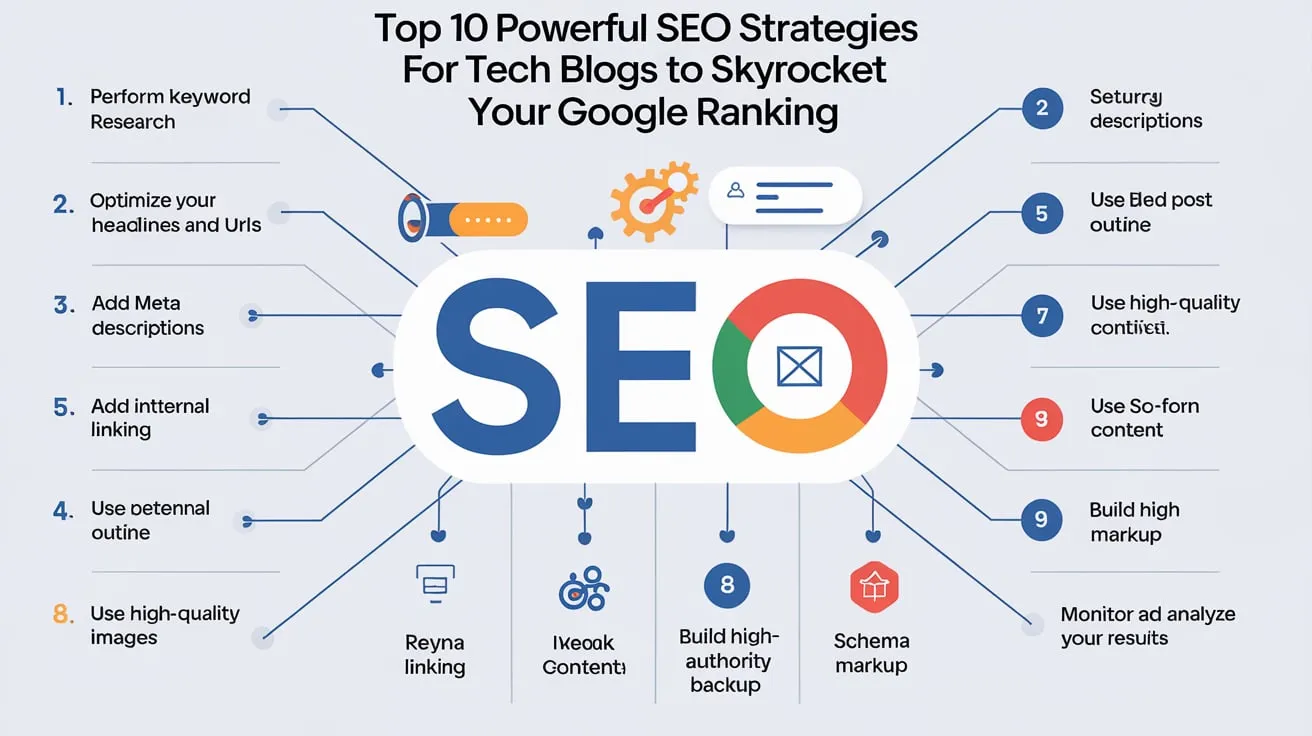Do you want your technology SEO for Tech Blogs to show up first in Google’s search results? You don’t need to worry about SEO. With the right strategies, getting your blog to rank highly is, quite literally, a piece of cake—especially when it comes to the subjects you cover. So let’s examine some handy tactics that get results!
The blog ‘Backlinko’, authored by Brian Dean, consistently ranks at the top. It achieves this through some of the most detailed and neater articles on the web. Those articles routinely get huge amounts of traffic because they provide clear value to the reader.
Introduction
Have you ever launched a technology blog only to find it going unnoticed? If so, you’re in good company. The articles that matter often remain unsung because they lack visibility to search engines. And wading through the mire of SEO (search engine optimization) can seem an insurmountable task. This handbook will assist you on your journey. Our main focus? Techniques and strategies that can help increase the visibility of your tech blog.
From the all-important Google algorithms to next-generation search engines powered by AI, we’ll cover the essentials of modern SEO and help you understand how to construct your blog in a way that is “semantic” (search-friendly) yet still makes sense (and is still enjoyable to read) to actual human beings. Whether your blog is personal or professional, we want to see you succeed, and these techniques will help you do that.
Table of Contents
1. Understanding Semantic SEO for Tech Blogs
Ever started a tech blog but no one’s stopping by to read it? You’re not alone. Top-notch articles get overlooked if they aren’t chummy with search engines. Today, with Google’s continuous upgrades, it’s not enough just to focus on keywords; your writing needs to be relevant and helpful.
Google’s algorithm changes (such as BERT or RankBrain) prioritize the quality of the content and the user’s search intent. In this handy guide, we’ll walk through effective SEO for Tech Blogs.
Our spotlight? Semantic SEO and Google NLP (Natural Language Processing) for improved rankings. It’s about making your content Google-friendly and showcasing your skills, knowledge, authority and trustworthiness (E-A-T). Itching to make your tech blog a hit? Let’s get started!
How to Implement Semantic SEO for Tech Blogs
- Topic Clusters: Don’t just aim for individual keywords, focus your writing on bigger themes. Say, you’re penning down thoughts about “5G Technology“. You should also explore linked areas such as “5G Applications“, “Effects of 5G on IoT“, and “Contrasting 4G and 5G“. When you join these articles together, it tells Google that your blog is a trusted guide on that theme.
- Answer User Questions: Use tools like AnswerThePublic or People Also Ask sections in Google search to find common questions. Incorporate these answers directly into your content.
- LSI Keywords: Latent Semantic Indexing (LSI) keywords are simply words or phrases related to your main keyword. Tools like LSIGraph or Semrush can help you discover these, making your content more contextually relevant.
2. Leveraging Google NLP for Better Ranking
Google’s NLP can analyze the meaning and relevance of your content. It’s crucial to structure your tech blog in a way that Google can easily understand what your post is about and find it helpful. You might want to mention tools like Google’s Natural Language API to test how well Google understands your content.
Tips to Optimize for Google NLP:
- Use Natural Language: Write like you’re talking to a friend. Avoid stuffing in keywords unnaturally; instead, answer questions and explain things clearly.
- Entity Optimization: Google recognizes entities—important nouns, concepts, or topics. When writing about a tech subject, make sure you include related entities. For example, if your topic is about “Quantum Computing,” related entities might include “superposition,” “qubits,” and “quantum algorithms.”
- Headers and Structure: Organize your content using H1, H2, and H3 tags. This helps Google understand the content hierarchy. Each section should logically connect to the previous one, making it easier for both readers and Google bots to follow.
3. Crafting Content That Google Loves (And Readers Too!)
To rank high, your content has to do two things: satisfy Google’s ranking criteria and provide value to your readers. It’s important to balance SEO practices with readability to avoid sounding too technical.
Writing High-Quality, Engaging Content:
- EEAT Principles: Show your Expertise by sharing personal insights or explaining complex tech concepts simply. Illustrate Experience by sharing anecdotes or case studies. Demonstrate Authority with data, references to credible sources, and linking to other experts. Build Trust with transparency—avoid misleading claims and cite your sources.
- Keyword Placement: Use your main keyword, “SEO for Tech Blogs,” in strategic places like the title, first paragraph, URL, and meta description. Sprinkle it naturally throughout, but focus on making it fit in a way that doesn’t feel forced.
- Length & Depth: Google prefers in-depth articles for tech topics. Aim for at least 1,500-2,000 words to cover topics comprehensively. Breaking longer articles into sections or using a table of contents can improve user experience. Dive deep into how-tos, pros and cons, comparisons, and practical applications.
4. Optimizing Tech Content for Featured Snippets
Getting into a featured snippet can drastically increase your blog’s visibility. To do this:
- Answer Questions Directly: For instance, if you’re writing a post titled “What is Edge Computing?A succinct 40 to 50 word paragraph that answers this question directly and early in the post makes for a clear and effective introduction in my mind. The author is drawing on their own observation and experience. Concision is frequently a virtue.
- Use Lists and Tables: Google loves lists. If you’re writing about “Top 10 Programming Languages for AI Development,” format it as a list so it can potentially be shown in a snippet. Using numbered or bullet lists can also improve readability for users who prefer skimming content.
- Structure for Skimming: Tech readers often skim content. Use bullet points, numbered lists, and plenty of subheadings to make your content more digestible.
5. Technical SEO for Tech Blogs
For a tech blog, the backend matters as much as the content itself.
Key Technical SEO Tips:
- Page Speed: Tech audiences are notoriously impatient. Use tools like Google PageSpeed Insights or GTmetrix to ensure your blog loads quickly.
- Mobile Friendliness: Google ranks mobile-optimized sites higher. Ensure your blog looks great and works well on phones and tablets.
- Adding schema helps Google understand your content better. For example, use Article Schema for blog posts to provide additional details like author, publish date, etc.
- URL Structure: Keep URLs clean and descriptive. Instead of “myblog.com/p1234,” use something like “myblog.com/5g-technology-benefits”.
6. Link Building and Interlinking
No SEO strategy is complete without link building.
- Internal Links:Hook up other matching articles on your tech blog to hold your audience longer. This action aids in cutting down the bounce rate, a sign Google appreciates. Also, think about how the fittingness of anchor text matters while making internal links since it helps Google grasp the linked content more efficiently.
- External Links: Use links pointing to trusted sites, but make sure they’re worthwhile. For example, you might cite articles from Moz (https://moz.com) or Search Engine Journal (https://www.searchenginejournal.com) to give more background. Citing tech papers, recognized tech websites, or formal documents informs Google that your content is thoroughly researched.
- Backlinks: To build authority, reach out for backlinks. Consider writing guest posts on other tech websites or collaborating with tech influencers who might link back to your blog.
7. Monitor, Test, and Adapt
SEO isn’t a one-and-done deal. You need to constantly refine your approach. Consider setting a regular schedule for SEO audits to identify and fix issues proactively.
- Google Search Console: Use Google Search Console to track how your posts are performing and adjust accordingly.
- Content Refreshing: Technology evolves fast. Refresh your previous posts with current details.Google loves fresh content, especially in tech niches where accuracy is key.
- User Engagement Metrics: Track time on page, bounce rate, and other user engagement metrics to see if your audience finds your content valuable. If engagement is low, tweak your content’s readability and flow.
Conclusion
Tech blog SEO might seem tough, but with proper strategies, you can continually climb higher in rankings and boost visitor count. Concentrate on serving value, knowing what your readers hunt for, and tweaking content to align with Google’s standards. The goal is to create a blog that doesn’t just enlighten, but also connects, offering readers comprehensive knowledge all under one roof.
Ready to boost your tech blog’s visibility? Start by applying these powerful SEO strategies and watch your rankings rise! Remember, SEO takes time—be patient, stay consistent, and keep creating valuable content.






